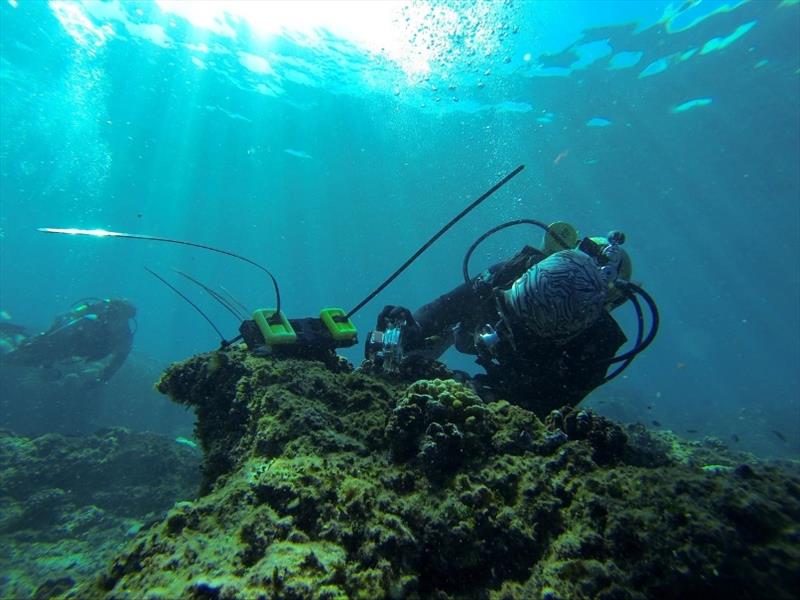
Little relief in the deep for heat-stressed corals
by NOAA Fisheries 16 Jan 2020 13:41 UTC

NOAA researcher and co-author Jeannette Clark documents an on-site temperature logger's serial number © NOAA Fisheries
A team of NOAA scientists recently examined more than a thousand hot water events on coral reefs across the Pacific Ocean.
Combining on-site monitoring with satellite records, they found that corals in deeper waters are just as exposed to marine heatwaves as those in shallower waters. They published these findings in Nature Scientific Reports.
This is bad news for coral reefs. These unique ecosystems have already experienced the devastating effects of three global coral bleaching events from hotter-than-normal water. Climate models project that temperatures will continue to rise.
"Scientists primarily use satellite-derived sea surface temperatures to understand heat stress and predict coral bleaching," said Dr. Scott Heron, an associate professor at James Cook University and partner of NOAA. "It's immediately available, it's convenient and it has global coverage. However, because the measurement is only at the very surface of the ocean, there is some uncertainty about how well it reflects what is actually happening on deeper reefs." In fact, the data might be underestimating the stress caused by these higher temperatures.
Measuring temperature on-site
To get an accurate understanding of how depth influences heat stress, researchers deployed subsurface temperature recorders at 457 coral reef sites between 2001 and 2017. The sites were spread among 49 islands in the western and central Pacific. They then compared the data with what the satellites were telling them.
"Our analysis of 1,453 heating events found that the vast majority of the time, there was no escape from the heat down to a depth of 125 feet (38 meters)," said Dr. Tom Oliver, co-lead author of the paper and research ecologist at NOAA's Pacific Islands Fisheries Science Center. He said this might seem counter-intuitive because the ocean is generally colder in deeper waters, but the deeper corals are also used to these cooler conditions.
"Heat stress isn't so much about the temperature itself, but how different today's temperature is from what the corals are used to experiencing," Dr. Oliver said. Even if there were significantly lower temperatures at depth, coral colonies might still die when their environment heats above its normal range. At those depths, they are likely acclimated to lower temperatures or to a reduced level of temperature variability than those at the surface.
The problem with sea surface temperature
Dr. Mark Eakin, a co-author and coordinator of Coral Reef Watch, touched on another note of bad news: The on-site monitoring found the satellites underestimated subsurface heat stress across the Pacific by an average of 40 percent.
"Mass coral bleaching is most commonly caused by abnormally high temperatures starting about 2 degreesF (1-2 degreesC) above the usual summer maximum for several weeks. Satellite temperature from the ocean surface is incredibly useful but doesn't give the full picture. Our study shows satellite surface measurements have actually underestimated heat stress at depth during powerful marine heatwaves."
Dr. Oliver highlights that both of these findings add to the bad news for corals in a warming world. "Coral reefs are already suffering the negative impacts of a hotter ocean, and projections suggest that these impacts will only get worse in the coming decades."
"Our two major findings—that there's no consistent refuge from this heat stress as you go deeper, and that we are likely underestimating this stress—both highlight the scale of the global problems that climate change poses to coral reefs," concluded Dr. Oliver.
Some refuges may exist
Although these general trends are bad news, the data revealed a glimpse of a silver lining: there were specific sites that appeared to be refuges. That is, heat stress at those sites was less than that measured by satellite data. Knowing the kinds of places in which these refuges are found can help reef managers strategize and respond to warming.
The refuges the study found were not evenly spread across the study domain. Nearly three-quarters of them occur in one region: the Northwestern Hawaiian Islands, established in 2006 as the Papahanaumokuakea Marine National Monument. This region has internal waves that usually bring up cold water during the hottest summer conditions. Oceanographic features like this aren't unique to this region, and by identifying their importance we may help find other areas in which corals may find some relief from a warming ocean.